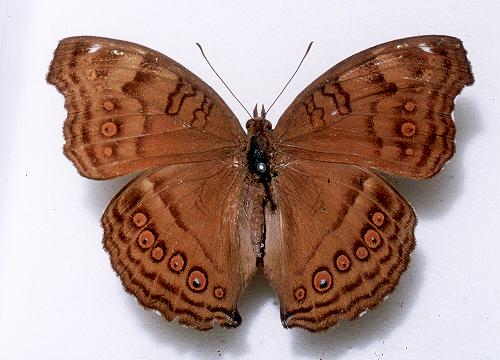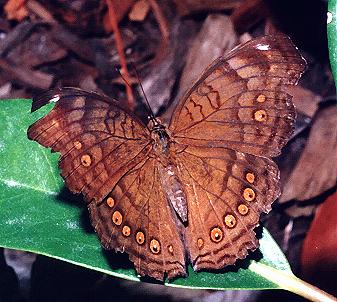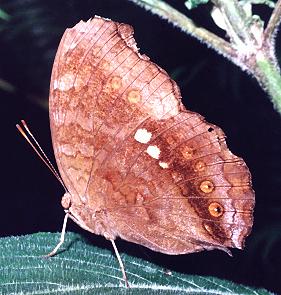
(Specimen: courtesy of the
Macleay Collection, Chau Chak Wing Museum, University of Sydney)
These Caterpillars are black except for the head
and the last abdominal segment, which are orange.
The bodies are cylindrical with a series of branched hairs
along the body. The caterpillars feed on various plants from the family
ACANTHACEAE, including :
Karamat ( Hygrophila angustifolia ),
Red Ivy ( Strobilanthes alternata ), and
Fever Root ( Ruellia tuberosa ).
The pupa is knobbly and is mottled brown in colour.
It hangs head down usually on a blade of grass near the foodplant.

(Specimen: courtesy of
Coffs Harbour Butterfly House)
The wings of the adult butterflies are
brown with a pattern of darker zig-zag lines and circles.
There are indistinct white spots by the wing tips
of the fore wings.

(Specimen: courtesy of
Coffs Harbour Butterfly House)
Underneath, They are are brown with fainter markings,
except for a row of white spots on each hindwing.
The butterflies have a wing span up to 6 cms.
The species has been found as various subspecies
across south-east Asia, including:
Bali,
New Guinea,
Philippines,
Singapore
Taiwan,
and as the subspecies zelima (Fabricius, 1775) in
Australia in:
Northern Territory, and
Queensland.
Further reading :
Michael F. Braby,
Butterflies of Australia,
CSIRO Publishing, Melbourne 2000, vol. 2, pp. 576-577.
Frank Jordan & Helen Schwencke,
Create More Butterflies : a guide to 48 butterflies and their host-plants
Earthling Enterprises, Brisbane, 2005, pp. 12, 59.
Carl Linnaeus,
Museum Siae Riae Mitis Ludovicae Ulricae Reginae,
1764, p. 279, No. 97.
(updated 3 January 2010, 20 November 2025)








